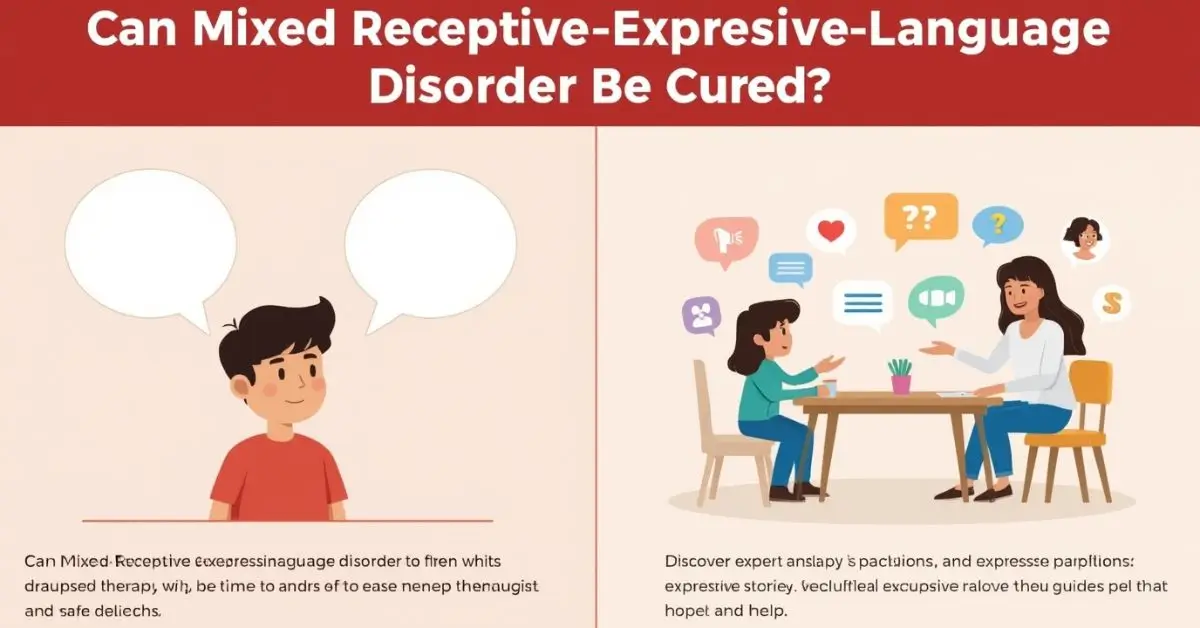HEALTH
Can Mixed Receptive-Expressive Language Disorder Be Cured?

If you’re a parent, teacher, therapist, or newly diagnosed adult, you might feel overwhelmed by the term mixed receptive-expressive language disorder. The big question you likely have is: Can Mixed Receptive-Expressive Language Disorder Be Cured?
You want answers. You want hope. And most of all, you want clear, trustworthy guidance on what to do next.
Short Summary
Can Mixed Receptive-Expressive Language Disorder Be Cured? Not in the traditional sense. But with early intervention, speech therapy, and consistent support, most individuals see major improvement in their communication skills and quality of life.
What Is Mixed Receptive-Expressive Language Disorder?
This disorder affects both how a person understands (receptive) and uses (expressive) language. Mixed receptive-expressive language disorder makes it hard to follow conversations, understand spoken directions, or speak clearly. You may wonder, Can therapy and support help someone overcome mixed receptive-expressive language disorder? — the answer often depends on treatment timing and intensity.
Signs Often Include:
- Trouble understanding simple directions
- Struggles with forming full sentences
- Limited vocabulary for their age
- Delayed child speech and language milestones
According to the DSM-5 (Diagnostic and Statistical Manual of Mental Disorders), mixed receptive-expressive language disorder falls under Communication Disorders, where both receptive and expressive capabilities are significantly below age expectations without the presence of general developmental delay.
What Causes Mixed Receptive-Expressive Language Disorder?
There’s no single cause, but common factors include:
- Brain development issues
- Family history of communication disorders
- Premature birth or birth trauma
- Neurological conditions like autism or ADHD
The NIH (National Institutes of Health) has funded studies showing early diagnosis and tailored speech-language therapy can significantly improve language outcomes, especially when started before the age of five. Still, many parents continue to ask: Can Mixed Receptive-Expressive Language Disorder Be Cured?
Can therapy treat mixed receptive-expressive language disorder, or does it last for life?

It’s treatable, not necessarily permanent. Children and adults with mixed receptive-expressive language disorder can improve significantly. That said, families still ask the big question: Can Mixed Receptive-Expressive Language Disorder Be Cured? The path to improvement is highly individual.
Success Depends On:
- Age at diagnosis (earlier is better)
- Severity of the disorder
- Access to quality speech therapy
- Support at home and school
Johns Hopkins Medicine states that “early intervention speech therapy increases the chances of overcoming many communication disorder symptoms.”
A clinical trial published by NIH (ClinicalTrials.gov ID: NCT03995755) reported measurable gains in expressive language skills among children who received structured early language interventions.
How Long Does It Take to Treat Mixed Receptive-Expressive Language Disorder?
This varies. Some children respond to therapy in a few months. Others may need years. Mixed receptive-expressive language disorder treatment timelines depend on each individual. But again, many parents keep asking: Can Mixed Receptive-Expressive Language Disorder Be Cured in months or years?
| Age Group | Typical Therapy Duration |
| Toddlers | 6 months – 1 year |
| School-aged children | 1-3 years |
| Adults (late diagnosis) | Varies, often ongoing |
Consistency is key. Regular sessions with a licensed speech-language pathologist (SLP) can lead to strong progress.
Real Case Study: Pediatric Neurologist Insight
Dr. Amina Khurshid, a pediatric neurologist in Chicago, shared that one of her patients—diagnosed at age 4 with mixed receptive-expressive language disorder—began structured speech therapy and made grade-level language gains within two years. Still, the family frequently asked, Can Mixed Receptive-Expressive Language Disorder Be Cured completely?
Can Children Outgrow Mixed Receptive-Expressive Language Disorder?
Some do, especially if the issue is mild and caught early. Others may need lifelong support but still achieve strong communication skills. This raises the key question again: Can Mixed Receptive-Expressive Language Disorder Be Cured fully? The answer lies in early action and consistent therapy.
With proper help, many children:
- Learn to express themselves clearly
- Catch up to peers in school
- Build strong social skills
Parent Testimonial
“My daughter was diagnosed with mixed receptive-expressive language disorder at 3. We started therapy twice a week, and now she talks confidently at age 6. We never thought we’d see this progress. Can Mixed Receptive-Expressive Language Disorder Be Cured? I’d say it can be overcome with love and help.” — Rita S., New Jersey
How Speech Therapy Helps Mixed Receptive-Expressive Language Disorder
Speech therapy for language disorders is the most effective treatment. Mixed receptive-expressive language disorder therapy often includes both individual and group sessions.
What Therapists Focus On:
- Listening and understanding words
- Sentence-building and grammar
- Expanding vocabulary
- Social communication
The American Speech-Language-Hearing Association (ASHA) recommends personalized and evidence-based intervention plans tailored to the child’s developmental needs.
ASHA Guidelines Recommend:
- Individualized goals
- Parental involvement
- Cross-disciplinary collaboration with schools and pediatricians
All of these strategies contribute to the ongoing goal: Can Mixed Receptive-Expressive Language Disorder Be Cured? While therapy may not be a one-time solution, it offers a path to meaningful improvement.
Best Strategies That Work
Parents and therapists use these proven approaches at home and in sessions to support individuals with mixed receptive-expressive language disorder.
- Visual aids: Use flashcards, charts, and storyboards
- Games: Try apps designed for language development
- Routine-based learning: Integrate new words into daily life
- Reading time: Read books together and ask open-ended questions
Recommended Tools:
- “First 100 Words” – a popular book for toddlers
- Speech Blubs app – used by SLPs for home practice
- Toca Boca – engaging games that build vocabulary
If you’re wondering, Can Mixed Receptive-Expressive Language Disorder Be Cured with at-home tools alone? — the answer is no. But these tools can strongly support professional therapy.
Final Thoughts
Mixed receptive-expressive language disorder can feel overwhelming, but it’s not hopeless. With early help, smart tools, and support from professionals, your child or loved one can thrive.
Trust in the Process
- Start therapy early
- Stay consistent
- Celebrate every win
You’re not alone in this. Mixed receptive-expressive language disorder doesn’t define your child’s future. And the question — Can Mixed Receptive-Expressive Language Disorder Be Cured? — may not have a simple yes/no answer, but there is real, hopeful progress ahead.
FAQ’s
What is the success rate of curing mixed receptive-expressive language disorder?
Success rates vary. Early treatment can lead to major improvements in over 70% of cases. Can Mixed Receptive-Expressive Language Disorder Be Cured? Not always, but significant progress is possible.
Can treatment help individuals overcome mixed receptive-expressive language disorder, or does it last a lifetime?
It is treatable. Many children and adults see big gains with therapy.
Can children outgrow mixed receptive-expressive language disorder?
Yes, some do. Especially when parents and professionals catch and treat it early.
Does early speech therapy help mixed receptive-expressive language disorder?
Absolutely. The sooner therapy begins, the better the outcome. Many professionals agree this is key to answering the question: Can Mixed Receptive-Expressive Language Disorder Be Cured?
What does therapy for mixed receptive-expressive language disorder cost?
It ranges from $50 to $200 per session depending on the clinic. Many insurance plans cover it.
Where can I find top-rated SLPs who treat expressive language delay near me?
Search your area on ASHA’s website or ask your pediatrician for referrals.
Any success stories about curing mixed receptive-expressive language disorder?
Yes! Many families report dramatic improvement within one year of regular therapy. They often start their stories with the same question: Can therapy and support help someone overcome mixed receptive-expressive language disorder? And many end with, “We saw a transformation.”
References
- American Speech-Language-Hearing Association (ASHA) — “Language-Based Learning Disabilities”
https://www.asha.org/public/speech/disorders/Learning-Disabilities/ - DSM-5 – Diagnostic and Statistical Manual of Mental Disorders, 5th Edition — APA
https://www.psychiatry.org/psychiatrists/practice/dsm - National Institutes of Health (NIH) — Clinical Trial: “Efficacy of Early Intervention for Receptive-Expressive Language Disorder”
https://clinicaltrials.gov/ct2/show/NCT03995755 - Johns Hopkins Medicine — “Language and Speech Disorders”
https://www.hopkinsmedicine.org/health/conditions-and-diseases/language-and-speech-disorders - National Institute on Deafness and Other Communication Disorders (NIDCD) — “Speech and Language Developmental Disorders”
https://www.nidcd.nih.gov/health/speech-and-language
HEALTH
Braven Health Smart Card — Benefits, Usage & Key Details
HEALTH
Tina Jones HEENT Shadow Health Assessment – Steps, Findings & Tips

The Tina Jones HEENT Shadow Health assessment is one of the most important modules in the Shadow Health Digital Clinical Experience (DCE) for nursing students. It focuses on the Head, Eyes, Ears, Nose, and Throat (HEENT) examination and helps learners develop hands-on clinical reasoning, data collection, and patient interaction skills through a virtual environment.
In this assessment, students interact with a simulated patient, Tina Jones, to gather both subjective and objective data. This experience is designed to prepare students for real-life patient encounters by emphasizing communication, observation, and assessment skills.
What Is the Tina Jones HEENT Shadow Health Assessment?
The Tina Jones HEENT Shadow Health module is an interactive simulation where you perform a focused assessment of the patient’s head, eyes, ears, nose, and throat. You collect health history, perform examinations, identify abnormalities, and document findings—just as you would in a real clinical setting.
Tina Jones is a 28-year-old patient presenting with mild nasal congestion and throat discomfort, giving students an opportunity to evaluate both normal and mild abnormal findings in a controlled digital environment.
Objectives of the Assessment
The main goal of the Tina Jones HEENT Shadow Health simulation is to enhance clinical competence and patient-centered communication. By completing this activity, students learn to:
-
Conduct a thorough health history relevant to HEENT.
-
Use correct examination techniques to assess each component.
-
Identify and interpret normal versus abnormal findings.
-
Document data accurately and provide education based on findings.
Through this process, students build confidence and learn how to connect theoretical knowledge with real-world application.
Step-by-Step Guide to Completing the HEENT Assessment
1. Establish Communication and Gather Health History
Start your assessment by greeting Tina Jones politely and introducing yourself. Establishing rapport helps her feel comfortable and encourages open communication. Ask open-ended questions such as:
-
“Can you tell me about any discomfort or issues you’re experiencing with your eyes, ears, nose, or throat?”
-
“When did your symptoms start?”
-
“Do you have any allergies or past medical conditions related to the head or neck?”
Tina often reports mild nasal congestion and occasional sore throat, symptoms consistent with seasonal allergies or mild upper respiratory irritation. Always document her responses carefully as subjective data.
2. Head and Face Examination
Inspect the head and face for symmetry, contour, and signs of trauma or deformity. Ask Tina if she has experienced headaches, dizziness, or facial tenderness. Palpate the frontal and maxillary sinuses to check for tenderness.
Typical findings during the Tina Jones HEENT Shadow Health assessment include:
-
Head: Normocephalic, no tenderness, symmetrical.
-
Face: No lesions, swelling, or drooping.
-
Sinuses: No tenderness to palpation.
Document these observations as objective data since they indicate normal health.
3. Eye Examination
The eye exam focuses on evaluating visual health and neurological function. Start by assessing visual acuity and observing external structures like the sclera, conjunctiva, and pupils.
Use the PERRLA method (Pupils Equal, Round, Reactive to Light and Accommodation) to assess pupil response. Tina’s typical findings are:
-
Pupils equal and reactive to light.
-
Sclera white, conjunctiva pink and clear.
-
No visual disturbances or eye pain.
| Eye Assessment Components | Expected Normal Findings |
|---|---|
| Visual acuity | Normal vision, no blurriness |
| Conjunctiva and sclera | Pink conjunctiva, white sclera |
| Pupil reaction (PERRLA) | Equal and responsive |
| Eye movements | Smooth and coordinated |
These results demonstrate a healthy ocular system and intact cranial nerves.
4. Ear Assessment
Inspect and palpate the external ear structures for lesions, redness, or discharge. Ask Tina about any hearing loss, tinnitus, or ear pain. Perform a quick whisper test to assess hearing acuity.
In most Tina Jones HEENT Shadow Health cases, findings are:
-
External ears symmetrical and intact.
-
No pain or discharge.
-
Hearing intact bilaterally.
If any earwax buildup or discomfort is present, document it and educate the patient about safe ear hygiene practices.
5. Nose and Sinus Examination
Next, assess Tina’s nasal structure and mucosa. Use a penlight to inspect inside the nostrils for redness, swelling, or discharge. Ask about nasal congestion, drainage, or allergies.
You may find mild nasal congestion and clear discharge, which are common in allergy-related cases. Palpate the sinuses for tenderness. Tina usually denies sinus pain, indicating no infection.
| Nasal Assessment Area | Common Finding | Interpretation |
|---|---|---|
| Nasal mucosa | Pink, moist | Healthy tissue |
| Septum | Midline, intact | Normal alignment |
| Sinuses | No tenderness | No sinus infection |
6. Mouth and Throat Examination
Inspect the lips, teeth, gums, tongue, tonsils, and pharynx. Ask if Tina has any difficulty swallowing or sore throat.
Her typical findings include slightly red pharynx, tonsils 1+, and moist oral mucosa. This mild redness usually indicates postnasal drip rather than infection.
Educate Tina about increasing water intake, using saline gargles, and avoiding irritants like smoke or strong fragrances.
Interpreting Common Findings in the Tina Jones HEENT Assessment
| Area | Typical Finding | Possible Interpretation |
|---|---|---|
| Head | Symmetrical, normocephalic | Normal anatomy |
| Eyes | PERRLA, conjunctiva clear | No visual disorder |
| Ears | Hearing intact | No hearing loss |
| Nose | Mild congestion | Seasonal allergies |
| Throat | Slight redness | Postnasal drip |
Understanding these findings helps you differentiate between benign conditions and those requiring further evaluation.
Documentation and Patient Education
Accurate documentation is essential in the Tina Jones HEENT Shadow Health module. Record both subjective data (patient-reported symptoms) and objective data (observed findings). Use correct medical terminology and avoid assumptions.
For patient education, advise Tina to:
-
Stay hydrated to reduce throat irritation.
-
Use a humidifier to ease congestion.
-
Avoid allergens and keep the environment clean.
-
Seek medical care if symptoms persist or worsen.
Document all teaching points and the patient’s understanding in your charting section.
Tips for Success in the Shadow Health HEENT Assessment
To perform well in the Tina Jones HEENT Shadow Health simulation, preparation and attention to detail are key. Review the anatomy and physiology of the head and neck region before starting. Take your time to ask all relevant questions—completeness affects your Digital Clinical Experience (DCE) score.
When documenting, make sure your statements are concise, objective, and free from judgmental language. Use the simulation’s checklists to verify you haven’t missed any component of the assessment.
Summary
The Tina Jones HEENT Shadow Health assessment is an excellent opportunity for nursing students to strengthen their clinical judgment, data collection, and communication skills. By understanding how to conduct a thorough head, eyes, ears, nose, and throat exam, learners gain confidence that translates to real-world patient care.
Mastering this module requires good preparation, active listening, and clear documentation. When completed effectively, it enhances your clinical readiness and overall nursing competence.
FAQs
1. How long does the Tina Jones HEENT Shadow Health assessment take to complete?
Typically, it takes between 45 to 60 minutes depending on your familiarity with HEENT systems.
2. Can I repeat the assessment to improve my score?
Yes, most nursing instructors allow multiple attempts to help you improve your DCE performance.
3. Are Tina Jones’s symptoms always the same?
They may vary slightly based on your responses and the simulation version, but the main findings remain consistent.
4. Do I need to use specific medical terminology in documentation?
Yes, using professional nursing and medical terminology improves clarity and grading accuracy.
5. What percentage of my course grade is this assessment worth?
This depends on your nursing program, but it typically contributes around 5–10% of your clinical evaluation score.
dow health
HEALTH
Shadow Health HEENT Assessment – Steps, Findings & Nursing Tips

The Shadow Health HEENT assessment is one of the most significant modules in the Shadow Health Digital Clinical Experience (DCE) program for nursing students. It focuses on examining the Head, Eyes, Ears, Nose, and Throat (HEENT) system through a virtual simulation with a digital patient—commonly Tina Jones.
This interactive exercise trains students to collect subjective and objective data, perform clinical reasoning, and document findings accurately. The simulation not only develops clinical skills but also builds confidence and prepares learners for real-world patient interactions.
What Is the Shadow Health HEENT Assessment?
The Shadow Health HEENT module allows nursing students to practice a complete head and neck evaluation using digital simulation technology. Through virtual interaction, students assess the patient’s physical appearance, inspect and palpate structures, and document normal or abnormal findings.
This assessment mirrors an in-person clinical encounter, helping students apply knowledge of anatomy, pathophysiology, and nursing communication. The virtual patient, usually Tina Jones, presents with mild symptoms like nasal congestion or throat irritation—making it an ideal practice scenario for developing focused assessment skills.
Objectives of the HEENT Module
The Shadow Health HEENT assessment aims to strengthen nursing students’ foundational skills in physical examination and patient communication. The main objectives include:
-
Performing a comprehensive HEENT assessment using correct techniques.
-
Gathering accurate health history data related to the head, eyes, ears, nose, and throat.
-
Identifying normal and abnormal findings through observation and palpation.
-
Enhancing nursing documentation and patient education skills.
These objectives ensure that students can deliver quality, evidence-based care in clinical settings.
Step-by-Step Process of the Shadow Health HEENT Assessment
1. Patient Introduction and History Collection
Every good assessment begins with effective communication. Greet the patient professionally and establish rapport. Ask open-ended questions to gather subjective data, such as:
-
“Do you have any headaches or dizziness?”
-
“Have you noticed changes in your vision or hearing?”
-
“Do you have any nasal congestion or sore throat?”
In the Shadow Health HEENT scenario, Tina Jones often reports mild nasal congestion and occasional throat discomfort, which gives you an opportunity to collect relevant data and build your clinical narrative.
2. Head and Face Examination
Inspect the head for shape, symmetry, and contour. Palpate for tenderness or lumps. Observe facial expressions and symmetry, noting any abnormalities. Ask about pain or pressure in the sinus areas.
Normal findings typically include:
-
Head is normocephalic (normal shape and size).
-
No lesions, masses, or tenderness.
-
Face appears symmetrical with no drooping or deformity.
These findings indicate healthy cranial and sinus structures.
3. Eye Examination
Eyes are a critical part of the HEENT exam. Observe for redness, discharge, or swelling. Assess visual acuity using a Snellen chart (if available) and evaluate extraocular movements to check for coordination.
Use the PERRLA technique—Pupils Equal, Round, Reactive to Light and Accommodation—to assess neurological function.
| Eye Assessment | Expected Normal Finding |
|---|---|
| Conjunctiva and sclera | Conjunctiva pink, sclera white |
| Pupillary response | Pupils equal and reactive |
| Eye movements | Smooth and coordinated |
| Vision complaints | None reported |
In Shadow Health HEENT, Tina Jones typically shows PERRLA response, indicating normal ocular health.
4. Ear Examination
Inspect the external ear for symmetry, color, and shape. Ask about hearing loss, ear pain, or ringing. Palpate gently for tenderness.
Perform a simple whisper test to evaluate hearing acuity. Check the ear canal for redness or wax buildup.
Tina’s findings often include:
-
No tenderness, swelling, or discharge.
-
Hearing intact bilaterally.
-
Tympanic membrane not visible (not part of the simulation exam).
Abnormal findings like redness or pain may indicate otitis externa or middle ear infection.
5. Nose and Sinus Examination
Inspect the nasal structure and mucosa. Use a penlight to check for swelling, redness, or discharge. Ask if the patient feels sinus pressure or blockage.
Common Shadow Health HEENT findings for Tina Jones:
-
Nasal mucosa pink and moist.
-
Mild congestion present.
-
No sinus tenderness on palpation.
| Nasal Exam Component | Typical Result | Interpretation |
|---|---|---|
| Nasal mucosa | Moist and pink | Normal |
| Septum | Midline, intact | Normal alignment |
| Sinuses | No tenderness | No infection |
These results suggest mild seasonal allergies or environmental irritation.
6. Mouth and Throat Examination
Inspect the lips, teeth, gums, tongue, tonsils, and pharynx. Note color, moisture, and presence of lesions or inflammation. Ask about sore throat, hoarseness, or swallowing difficulties.
In the Shadow Health HEENT module, Tina’s findings often include:
-
Oral mucosa moist and pink.
-
Tonsils 1+ (normal).
-
Pharynx slightly red due to postnasal drip.
Educate Tina about staying hydrated, using saline gargles, and avoiding allergens or irritants.
Common Findings and Their Meanings
| HEENT Component | Common Finding | Interpretation |
|---|---|---|
| Head & Face | Symmetrical, normocephalic | Normal anatomy |
| Eyes | PERRLA, clear conjunctiva | Normal vision & response |
| Ears | Hearing intact | No hearing impairment |
| Nose | Mild congestion | Seasonal allergies |
| Throat | Mild redness | Postnasal drip or mild irritation |
Understanding these results helps distinguish between normal variations and early signs of infection or allergy.
Documentation and Patient Education
Documentation is a key part of the Shadow Health HEENT assessment. Record both subjective data (what the patient reports) and objective data (what you observe). Use concise, professional language and structure your findings under appropriate headings.
Example documentation snippet:
“Patient reports mild nasal congestion and occasional sore throat. Head normocephalic and symmetrical. Pupils PERRLA. Conjunctiva clear. External ears symmetrical, no tenderness. Nasal mucosa pink, mild congestion noted. Pharynx slightly erythematous without exudate.”
After the exam, provide education on hydration, avoiding allergens, using over-the-counter saline sprays, and seeking medical attention if symptoms worsen.
Tips for Success in the Shadow Health HEENT Module
To excel in the Shadow Health HEENT assignment, practice both your assessment and communication skills. Read the patient’s cues carefully and respond appropriately.
-
Ask open-ended questions before moving to focused ones.
-
Use medical terminology correctly in documentation.
-
Don’t skip inspection or palpation steps—they affect your DCE score.
-
Review HEENT anatomy and common pathologies before starting the module.
-
Double-check your documentation before submission.
Consistency and thoroughness are key to scoring well and mastering clinical skills.
Summary
The Shadow Health HEENT assessment is a vital learning experience that bridges classroom knowledge with clinical application. By interacting with the virtual patient, Tina Jones, students practice data collection, physical examination, and nursing documentation in a safe, controlled setting.
Through this simulation, learners enhance their diagnostic reasoning, improve patient interaction, and build confidence for real-world clinical practice. Understanding the HEENT system in detail ensures nurses can detect subtle abnormalities early and provide appropriate care interventions.
FAQs
1. How long does the Shadow Health HEENT assessment take?
It usually takes between 45–60 minutes, depending on your speed and experience.
2. Can I retake the HEENT module to improve my grade?
Yes, most instructors allow multiple attempts to boost your DCE score and refine your skills.
3. Does the patient’s response change each time?
Slightly—Tina Jones’s answers can vary depending on how you phrase questions and which areas you explore.
4. Is the HEENT module required for all nursing programs?
Many BSN and ADN programs use Shadow Health HEENT as a core clinical simulation.
5. What skills does this module help develop?
It strengthens assessment skills, communication, documentation accuracy, and clinical reasoning—core components of nursing practice.
-

 GENERAL3 months ago
GENERAL3 months agoRobert Hubbell Wikipedia: What’s His 2025 Biography Guide?
-

 EDUCATION5 months ago
EDUCATION5 months agoJay Kuo Substack: Unpacking the Voice of Legal Insight
-

 GENERAL5 months ago
GENERAL5 months agoDream Cake: A Decadent Delight Worth Savoring
-

 GENERAL5 months ago
GENERAL5 months agoChris Hedges Substack: A Voice of Dissent in the Digital Age
-

 EDUCATION5 months ago
EDUCATION5 months agoEconomic Blackout Results: The Financial Domino Effect
-

 TECHNOLOGY6 months ago
TECHNOLOGY6 months agoHow to Cancel Substack Subscription
-

 GENERAL6 months ago
GENERAL6 months agoMax Azzarello Substack: Inside the Mind of a Radical Truth-Seeker
-

 ENTERTAINMENT5 months ago
ENTERTAINMENT5 months agoTyler the Creator Dad Truth

